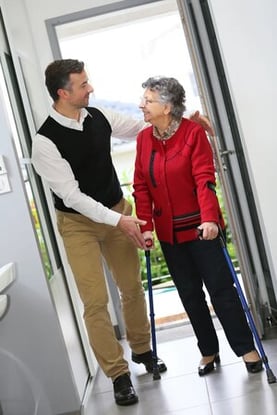Aging in place at home remains the most popular option for senior living. According to AARP, over...
What is a Care Plan?
For anyone living at an assisted living or skilled nursing facility, a care plan (for skilled nursing) or service plan (for assisted living) is required to promote resident health and wellbeing.
This comprehensive plan details all aspects of how a resident's care will be delivered. It guides the staff in rendering care tailored to the resident.
Step 1 – The Assessment
The creation of a care/service plan starts before a resident's official admittance to the facility. Though in some cases, it takes place on move-in day. The new resident, their family, and the facility staff participate in a meeting known as a Care Conference to assess the required level of care. Among the areas covered in the assessment are:
- Activity limitations
- Background
- Behavior
- Cognition and mental health
- Communication ability including language
- Cultural considerations
- Decision-making ability
- Dietary requirements and preferences
- Medical needs
- Personal preferences
- Physical health and functioning
- Sensory including vision and hearing
- Spiritual needs
- Therapy and nursing care needs
Much of the assessment focuses on the Activities of Daily Living (ADLs). These are fundamental activities a person should be able to do independently. An inability to handle one or more ADLs often drives the decision to move to a senior living situation.
The two types of ADLs included in the assessment are Basic and Instrumental. Basic ADLs include:
Basic ADLs include:
- Bathing
- Dressing
- Grooming
- Mouth care
- Toileting
- Transferring bed/chair
- Walking
- Climbing stairs
- Eating
Instrumental ADLs (IADLs) are higher-level activities that a person does on their own living at home. An IADL assessment is typically more applicable for assisted living. They include:
- Shopping
- Cooking
- Managing medications
- Communicating via phone or mail
- Doing housework
- Doing laundry
- Driving or using public transportation
- Managing finances
After collecting all the information, the facility staff drafts a detailed plan that addresses all assessment areas. Input to the plan ideally should come from multiple professionals such as nurses, dietitians, social workers, therapists, activities staff, and anyone else involved with the resident's care.
The plan draft then needs to be discussed with the resident and the resident's family. This serves two purposes. First, the family can determine if all areas of concern have been addressed. Second, it serves to educate the resident and family and set expectations about how care will be delivered. The goal is to avoid any communication lapses that would lead to future problems with the resident's care.
Step 2 – Ongoing Care Conferences
The care or service plan is a living document. It needs to be updated on a set schedule or as the resident's needs change. Follow-up Care Conferences are often the forum for reviewing the plan. Residents and their families must be prepared to ask questions, so no concerns are overlooked.
Questions to Ask
Residents and their families should thoroughly understand how the facility will address the resident's care needs. In both the initial Care Conference and subsequent meetings, it helps to prepare a list of questions. Below are some examples:
Questions for the Initial Assessment
- How often do staff members check on residents?
- How does the staff become aware of any changes in the resident's care needs?
- What therapy is recommended, and how will that be administered?
- How will dietary restrictions and preferences be accommodated?
- How can a resident send an emergency alert, and what is the response time?
- Who will be administering any medications, and what training do they have?
- Who is the best person to contact if the family has any concerns or questions?
- When is another reassessment planned?
Questions for Follow-Up Care Conferences
 Has the resident's health or behavior changed since the last meeting, and what actions were taken in response?
Has the resident's health or behavior changed since the last meeting, and what actions were taken in response?- What changes in medication, if any, have occurred, and why?
- What medical treatment, including both routine exams and non-routine care, has occurred?
- Has the resident been eating and drinking normally?
- What things have the residents been doing to stay active?
- What progress has been made toward Care Plan goals?
- Does the resident have any needs for clothing or other personal items?
- Are staff levels and skills appropriate to meet the plan goals?
The Care Plan is the number one tool used to describe what the optimal care should be for the resident. It sets mutually agreed-upon expectations for the resident, their family, and the facility staff, so everyone shares the same vision for the resident's optimal level of care.
Visit our Long-term Care Resources page for more helpful content about planning for care!






